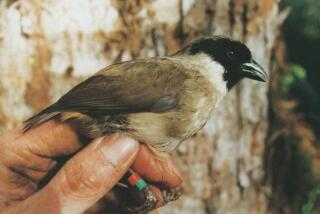Scope of Endangered Act Needs Broadening
- Share via
The tiny Tellico Dam snail darter certainly enjoyed it. Now, to the dismay of Pacific Northwest loggers, so does the northern spotted owl. But could the world’s largest known living organism enjoy protection under the controversial Endangered Species Act?
Once upon a time, California’s beautiful General Sherman sequoia (which does enjoy legal protection) was the largest known living thing. Just last month, however, Nature magazine declared a giant 38-acre Armillaria bulbosa fungus in Michigan the world’s largest organism.
Now, it appears that a Washington state Armillaria ostoyae fungus that covers 1,500 acres--more than 2.5 square miles--deserves that title. Although most of the fungus lives underground, its surface signs include tree rot and edible mushrooms. Scientists estimate this huge fungus at somewhere between 400 and 1,000 years old.
Clearly, a 1,500-acre fungus doesn’t grow on trees (well, actually, it does--but you get the idea). But if some enterprising huckster decided to slice off the tastier bits of the Washington fungus and market it (“Have a bite of the world’s biggest mushroom!”), this arguably unique organism has no special standing in bio-diversity policy or law. (Bio-diversity is the scientific community’s term for the preservation of disparate life forms and habitats.) The Endangered Species Act is crafted in a way that puts even unique organisms within an ecosystem beyond protection.
“We protect species, not individuals,” says Jay M. Sheppard, a staff biologist with the division of endangered species at the U.S. Fish and Wildlife Service. “Extinction is the key word. Only if a species is threatened with extinction do we step in. The act doesn’t address issues of size, uniqueness or importance to man.”
But the very size of the organism, the way it has woven itself into the very fabric of its ecosystem over centuries, begs the question of whether this fungus should merit the same sort of protection given to snail darters and spotted owls. “It throws into question what we think is an organism,” says Jim Blomquist, the Washington director of the Sierra Club’s public lands programs. “It opens up the question of what an individual is; it upsets our easy views of plants and animals.”
Indeed, Blomquist stresses that while much attention has been focused on individual species, the real issue now has to be ensuring the preservation of the ecological habitats that house these species. “We’ve gone beyond the point of protecting just species to protecting ecological systems,” agrees the Audubon Society’s Jim Waltman. “We shouldn’t haveto expect that the Endangered Species Act will protect whole ecosystems.”
Environmentalists argue that the most cost-effective and efficient way to protect individual species is to preserve appropriate ecosystems--whether they be wetlands or forests.
The debate pitting economic versus environmental interests over a spotted owl, a snail darter or a fungus simply obscures--rather than illuminates--the larger issue: how best to define and preserve habitats.
Of course, it’s one thing to protect what the environmentalists like to call the “charismatic mega-fauna”--the bald eagles, condors or spotted owls--that appear as beautiful, vibrant, living creatures. It’s quite another thing to go to the mat to preserve the unique ecosystem of a giant fungus, an organism that has roughly the texture of rotting fabric. Even if a unique fungus is an essential part of an ecosystem, who will lead the Friends of the Fungus organization to protect it against developers?
“For the American public,” the Sierra Club’s Blomquist says, “it’s probably better to talk about them as mushrooms rather than as fungi.” Clearly, public relations is a huge part of environmentalism.
But precisely because the Endangered Species Act places ecology before economy, we may someday have to ask if a giant fungus should “stand” in the way of regional economic development. It’s time to shift the debate away from simplistic dichotomies of “Owls versus Jobs” and toward the broader policy issues of what kind of ecosystems we are prepared to respect and protect. In the 1990s, the issue is not “endangered species”; it’s “endangered environments”--whether those environments have mushrooms or not.
More to Read
Sign up for Essential California
The most important California stories and recommendations in your inbox every morning.
You may occasionally receive promotional content from the Los Angeles Times.










